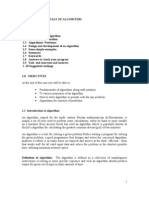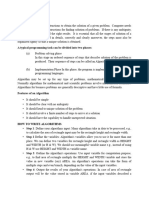0% found this document useful (0 votes)
15 views2 pagesUsing Algorithms
An algorithm is a structured set of instructions designed to solve a problem or complete a task, requiring the steps to be followed in the correct order for accurate results. The document provides examples of creating and following algorithms, particularly in navigating a route, emphasizing the importance of clarity and sequence in instructions. It also includes assessment ideas and key vocabulary related to algorithms.
Uploaded by
frankobstenCopyright
© © All Rights Reserved
We take content rights seriously. If you suspect this is your content, claim it here.
Available Formats
Download as DOCX, PDF, TXT or read online on Scribd
0% found this document useful (0 votes)
15 views2 pagesUsing Algorithms
An algorithm is a structured set of instructions designed to solve a problem or complete a task, requiring the steps to be followed in the correct order for accurate results. The document provides examples of creating and following algorithms, particularly in navigating a route, emphasizing the importance of clarity and sequence in instructions. It also includes assessment ideas and key vocabulary related to algorithms.
Uploaded by
frankobstenCopyright
© © All Rights Reserved
We take content rights seriously. If you suspect this is your content, claim it here.
Available Formats
Download as DOCX, PDF, TXT or read online on Scribd
/ 2





























































